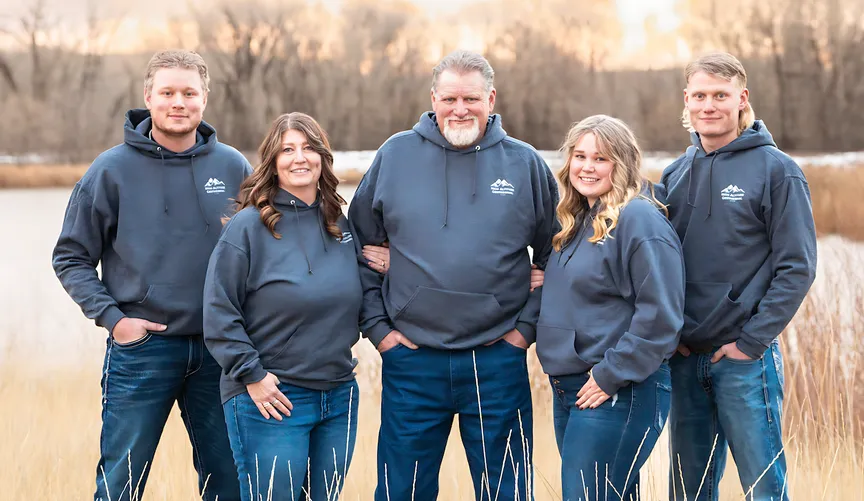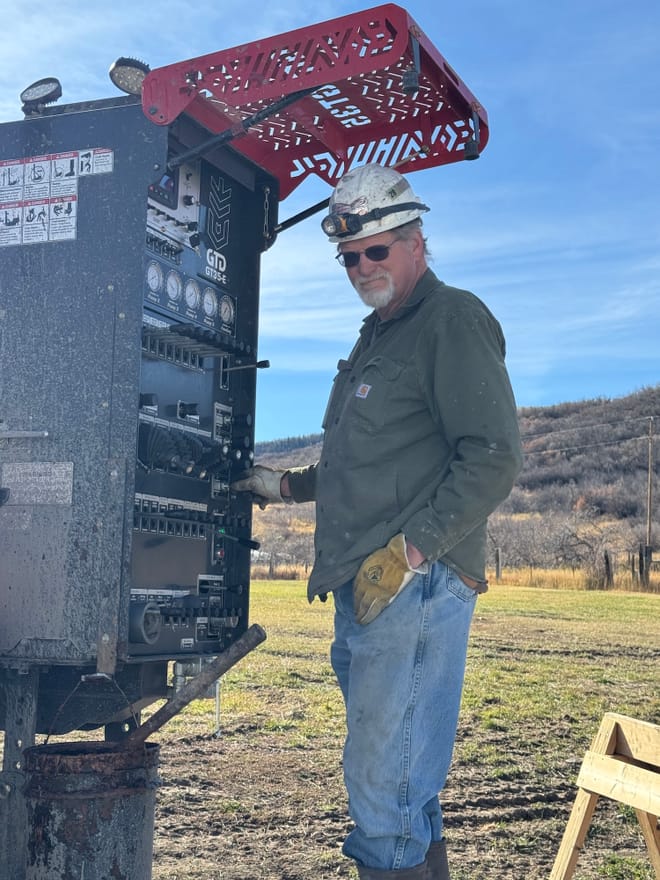
When Matt Cooper found out in 2020 that the northwest Colorado coal mine where he works would close by the end of the decade, he was pissed.
Questions raced through his mind: Why didn’t the mine’s leaders fight harder to keep it open? And why was the coal industry being singled out? “Is it political?” he wondered.
But coal has been declining in the U.S. for over 20 years, outcompeted by cheap fossil gas and, more recently, even cheaper renewables. Cooper eventually accepted there was nothing he could do — except plan for what’s next.
Now the coal-fired Craig Station is set to shutter in 2028, and the Colowyo mine that feeds it is halting production by the end of the year. For his part, Cooper is choosing to dig for a different kind of energy: geothermal, the renewable heat beneath our feet.
“It works wonderfully well,” said Cooper, a longtime Hamilton, Colorado, resident with a snowy-white goatee and a strong Western accent. Geothermal energy from the shallow earth can be tapped to superefficiently heat and cool individual buildings or even entire neighborhoods. Leveraging his ample experience operating heavy equipment at the mine, Cooper has started a new business, High Altitude Geothermal, to drill for the resource. With the startup’s first projects underway, he’s working alongside his wife, daughter, and two sons, both of whom are also coal miners.
Others in the fossil-fuel industry could follow, finding a foothold in geothermal as clean energy takes off. Colorado plans to decarbonize its economy by 2050, and its remaining six coal plants are shutting down by the end of the decade. The Centennial State’s six active coal mines, which employed roughly 900 workers as of July, will likely shut down along with them.
The northwest corner of the state is the epicenter of the transition. And affected communities stand to lose not only jobs, but big chunks of their tax base. Moffat County, where Cooper lives, will be the hardest hit; Craig Station made up a third of its property taxes in 2022.
In 2019, Colorado created the Office of Just Transition, the first state-level office in the nation dedicated to providing personalized support to coal workers and their families, as well as funding to their communities.
“Small towns have this tendency to be dependent on one or two large employers,” said Wade Buchanan, director at the just-transition office, which helped the Coopers connect to state agencies as they worked on their business concept. “You want to help communities find a way to be more diversified, so that their fortunes are not subject to the fortunes of any single employer.”
Buchanan said he’s thrilled by the Coopers’ venture into geothermal, a tech that the state and federal government are backing with incentives. “They’re trailblazers showing the way for a lot of other people that opportunities exist.”

Cooper still isn’t happy that Colorado’s coal industry is sunsetting. “We produce some of the cleanest coal in the nation,” even if it is a fossil fuel, said Cooper, who plans to keep doing shift work at the coal mine until it closes. President Donald Trump also dubs coal clean, and Cooper reports feeling more aligned with Republicans than Democrats.
He’s clear-eyed that change is inevitable, though, like it or not. “I can’t save the coal industry,” Cooper said.
The Trump administration, meanwhile, has undertaken the Sisyphean task of resuscitating coal in the U.S. by, among other tactics, forcing uneconomic coal plants to keep running past their planned closure dates.
Cooper, who worked at a heat- and power-generating plant when he was in the military, isn’t a fan of most forms of renewable energy. “Windmills are ugly things to me,” he said — a view shared by the U.S. president. He finds batteries unpalatable. And solar panels send jobs overseas, he said.
“When you’re buying solar panels from China, I don’t think that’s the right way to go. If you’re going to buy the things, they ought to be built here,” Cooper said. (Though perhaps not a well-publicized statistic, domestic solar manufacturing employed about 34,000 workers in 2024.)
Geothermal is an up-and-coming energy source Cooper can get behind. Hooked up to heat pumps, it’s the most efficient way to warm and cool buildings.
In a geothermal system, loops of flexible pipe are installed ten to hundreds of feet deep into the ground. At these depths, the earth is a fairly stable 45 to 75 degrees Fahrenheit, funneling a ready source of heat in cold weather to a building’s electrically powered geothermal heat pump. In the summer, the appliances provide air conditioning by dumping a building’s extra warmth underground.

Geothermal heat pumps are extremely efficient. They can deliver the same amount of heating as a fossil-fueled or electric-resistance system using just a fourth or even a sixth of the energy.
“In northwest Colorado, you can pay $700 a month for propane to heat your house, or $400 for natural gas,” said Cooper. “That’s a chunk of change, because our winter up here lasts about five to six months — about half a year where you’re going to be heating your home.” And the cold cuts like a knife: Cooper recalls winters in the area with lows in the minus 50s and 60s Fahrenheit.
Plus, a geothermal heat pump actually “helps the grid out,” Cooper said. The appliances are not only superefficient but also provide warmth steadily, rather than in bursts. That reduces peaks in power demand, keeping electricity more affordable for everyone.
Geothermal systems aren’t yet widespread. Most people don’t know the tech exists, and the up-front cost to install them is typically two to three times the price tag of an air-source heat pump or gas furnace plus a central air conditioner.
But the higher costs in northwest Colorado are partly due to far-flung geothermal drillers having to haul their equipment across the Rocky Mountains, said Cooper, who’s been spinning up the startup in his off-time. “I think I can keep my costs of mobilization down, and so that makes the product more affordable.”
His geothermal drilling business will be the first in Moffat County and neighboring Routt and Rio Blanco counties — a region home to more than three-quarters of the roughly 1,700 workers that make up Colorado’s coal industry and its supply chain. The state is backing High Altitude Geothermal, providing four years of tax relief and a $40,000 grant for operations through the economic development program Rural Jump-Start.

For now, the startup consists of Cooper and his family members. His wife, Kristine, is helping with administrative work. His daughter, Anna, handles operations. His sons, Matthew and Nathan, are drilling alongside him. Anna is also certified to do that work, so she can step in when the need arises. But as business picks up, Cooper aims to expand to a second crew and hire more people — especially other miners in the area.
“Hiring displaced coal workers was part of Matt’s ‘why’ for starting this business,” Kristine said. “He wanted to be part of the solution for the employment of these individuals.”
Going into geothermal energy “felt so right,” Anna said. “It’s a wonderful resource that everyone has access to. It’s there all the time.” And it’s a boost to the local economy. “It’s really exciting … when you have something that’s so powerful.”
High Altitude Geothermal has already secured its first contracts: retrofits of two homes in Moffat County. The Coopers are also bidding on two large-scale commercial projects in the municipalities of Steamboat Springs and Gunnison. They’re building a future with geothermal energy, regardless of the federal push for coal.
“There’s some people that are holding out that somehow Trump will be able to make coal viable again and make the power plants stay open,” Cooper said. “Maybe they’ll be right. … I have no idea. But my intuition is that this ball is rolling, and I don’t see it stopping.”
“So you better just try to figure out what’s next for you.”